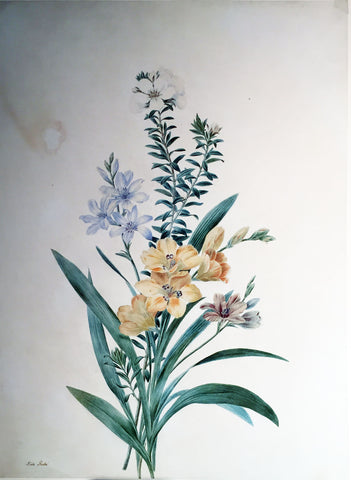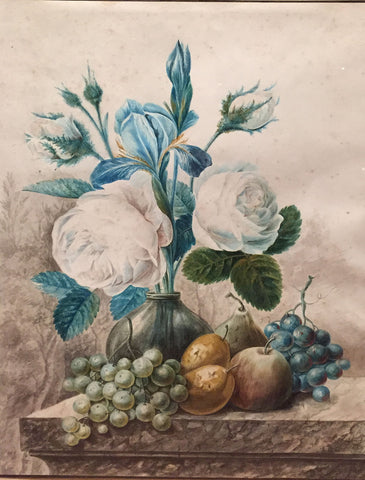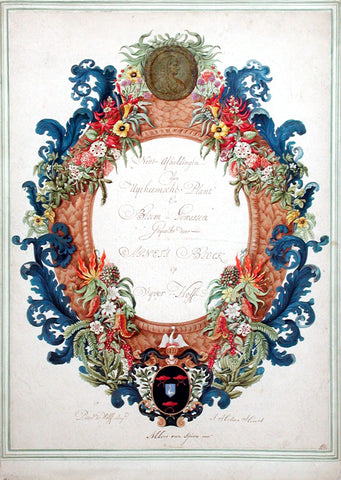
Priscilla Susan Falkner Bury (British, 1799–1872), Amaryllis Reginae. Fairfield, 31 March, 1829.
Priscilla Susan Falkner Bury (British, 1799–1872)
Amaryllis Reginae. Fairfield, 31 March, 1829.
Watercolor and gouache on paper with ink inscription
Paper size: 17 1/2 x 12 1/2 in.
Frame size: 24 3/4 x 20 in.
Provenance: Private Collection, Hertfordshire.
A Mexican Lily or Queen’s Horse-Star, with early oak frame supplied by W. Hibbert of Sheffield. Published as plate 24 in Bury’s celebrated “A Selection of Hexandrian Plants”: “The plant here represented has been above thirty years in the Fairfield hothouse and flowers very freely every spring - the following correct description is taken from Professor Martyn’s edition of Miller’s dictionary, published in 1768 - “...It flowered in Mr. Fairchild’s garden at Hoxton, in 1728, when the late Dr. James Douglass (a celebrated Anatomist,) caused a figure of it to be drawn, and wrote a folio pamphlet on it. He gave it the title of Lilium Reginae, because it was in full beauty on the 1st of March, which was the birth-day of the late Queen,” (Caroline of Auspach, wife of George II.) the roots were brought from mexico, and it is therefore called the Mexican Lily, among Gardeners...”
Bury grew up in Lancashire and drew plants “raised in the greenhouses of her family home, Fairfield (demolished 1913), 2 miles east of Liverpool and, by 1829, had enough studies of lilies and allied plants for publication, a venture promoted by her friend, William Swainson. She modeled her proposed book, then tentatively named ‘Drawings of lilies,’ on William Roscoe’s Monandrian Plants (1824-8), with the plates to be accompanied by brief letterpresses based on her notes. Indeed, she even used Roscoe’s book prospectus as a model for her own. In it, she advertised her ‘Drawings of Liliaceous Plants arranged by Botanists in the genera Crinum, Amaryllis, Pancratium …’, to appear in ten numbers, each of five plates lithographed by Hullmandel, subscribers paying a guinea a name, others 27s.
“On 4 March 1830, at Walton on the Hill, Priscilla Falkner married Edward Bury (1794-1858), a railway engineer; the couple had at least three sons, born between 1831 and 1835. In 1831 Priscilla Bury’s drawings began to be published as A Selection of Hexandrian Plants, the large (64 cm × 48 cm) plates being engraved by Robert Havell; the work had only seventy-nine subscribers. Fifty-one plates appeared in ten fascicles, the last in 1834, but whether or not the text is Bury’s is unclear. The plates are fine-grained aquatints, partly printed in colour and retouched by hand... The published work has been praised as ‘certainly one of the most effective colour-plate folios of its period’ (Blunt and Stearn, 248)” (D. J. Mabberley for DNB).
Havell’s skill was beautifully married to Bury’s watercolors of hexandrian plants. Tomasi notes: “[he] managed to translate the artist’s fine watercolours into aquatints of even more striking beauty,” described by Dunthorne as “finely coloured plates of perfect technique, very decorative and ‘modern’’’ in feeling. Just 79 subscribers are listed (including Audubon), and it is unlikely that the number produced was much beyond that, accounting for its scarcity, which is noted by both Stafleu and Cowan and Pritzel.
William Harrison, a merchant, living in Rio de Janeiro during the 1830s and 1840s, sent many beautiful Brazilian plants, to his brother Richard in Liverpool, whose residence at Aigburth was in those days a Mecca to which lovers of exotic flowers paid annual pilgrimages.
We Also Recommend





